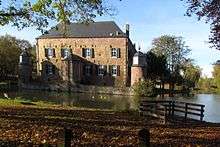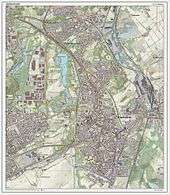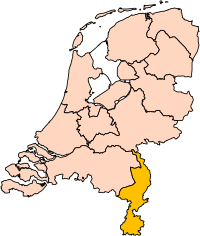Kerkrade
Kerkrade (Kerkrade dialect: Kirchroa; German: Kerkrade or Kirchrath)[5] is a town and a municipality in the southeast of Limburg, the southernmost province of the Netherlands. It forms part of the Parkstad Limburg agglomeration.
Kerkrade Kirchroa | |
|---|---|
 Kerkrade city hall | |
 Flag  Coat of arms | |
.svg.png) Location in Limburg | |
| Coordinates: 50°52′N 6°4′E | |
| Country | Netherlands |
| Province | Limburg |
| Government | |
| • Body | Municipal council |
| • Mayor | Jos Som (CDA) |
| Area | |
| • Total | 22.13 km2 (8.54 sq mi) |
| • Land | 21.90 km2 (8.46 sq mi) |
| • Water | 0.23 km2 (0.09 sq mi) |
| Elevation | 155 m (509 ft) |
| Population (January 2019)[4] | |
| • Total | 45,642 |
| • Density | 2,084/km2 (5,400/sq mi) |
| Demonym(s) | Kerkradenaar |
| Time zone | UTC+1 (CET) |
| • Summer (DST) | UTC+2 (CEST) |
| Postcode | 6460–6471 |
| Area code | 045 |
| Website | www |
Kerkrade is the western half of a divided city; it was part of the German town of Herzogenrath until the Congress of Vienna in 1815 drew the current Dutch-German border and separated the towns.[6] This means that the eastern end of the city marks the international border.
The two towns, including outlying suburban settlements, have a population approaching 100,000, of which nearly 47,000 are in Kerkrade.
History
The history of Kerkrade is closely linked with that of the adjacent town of Herzogenrath, just across the German border.[7] Herzogenrath began as a settlement, called Rode, near the river Worm (or Wurm in German) in the 11th century. In 1104 Augustinian monks founded an abbey, called Kloosterrade, to the west of this settlement.
It was called 's-Hertogenrode or 's-Hertogenrade (Dutch: the Duke's Rode) after the duchy of Brabant took control over the region; in French it was called Rolduc (Rode-le-duc). As is the case for many parts of the Southern Netherlands, the place changed hands several times in the last few centuries. It was under Spanish control from 1661, Austrian between 1713 and 1785 and French between 1795 and 1813. In 1815, when the kingdom of the Netherlands was formed (see Vienna Congress), the border was drawn through Herzogenrath, the western part being Kerkrade.
In the 18th century the monks of Rolduc began small-scale coal mines. More modern exploitation by others started in 1860, causing Kerkrade to grow significantly, especially as a consequence of the permanent settlement of mainly Southern-European miners in this Northern-European place. When the Willem Sophia mine was opened around 1900, the town grew even more rapidly, absorbing old villages like Chèvremont. In the decades following 1960, all the mines in Limburg were closed.
One of the oldest buildings in the municipality is Erenstein, a castle the origins of which lie in the 14th century.
The border along Nieuwstraat/Neustraße


One part of the border between the Netherlands and Germany runs along the middle of the street Nieuwstraat/Neustraße. The border was heavily fortified by the Germans during World War I and World War II,[6] but because of relatively unrestricted cross-border travel within the European Union, following World War II marked only with a low wall, about 30 cm high, running along the length of the street (borders were at that time designed to be unpassable by vehicles, except at border crossing, but no fence for pedestrians).[6] There was a separate 2-way road on each side, and cars had to pass through the official crossing points, but pedestrians could readily step over the wall (although there were signs informing of the border). In 1995, the wall was removed completely as part of the new Schengen Area agreement.[6] Nieuwstraat/Neustraße is now a single two-way road, with the extra space now occupied with trees and bicycle lanes. The border is unmarked, and is crossed even when going round a roundabout or overtaking a vehicle.
The two towns now share some of their public services,[8] and promote themselves as a binational "City of Eurode" for economic development purposes.[6] They share a binational office complex which uses the Eurode name, and is built so that the border passes directly through the centre of the building's main lobby, with one wing of the building in Kerkrade and the other in Herzogenrath.[9]
Population centres

Kerkrade's outlying neighborhoods and housing developments include:
- Bleijerheide
- Chevremont
- Eygelshoven
- Gracht
- Haanrade
- Holz
- Hopel
- Kaalheide
- Mucherveld
- Nulland
- Ondernemend gedrag
- Rolduc
- Rolduckerveld
- Spekholzerheide
- Terwinselen
Music
Every fourth year the World Music Contest, a competition for amateur, professional, and military bands, is held in Kerkrade.[10] Also, for the last three years, the Drum Corps Europe championships have been held here.
Transportation

Kerkrade has 4 railway stations:
Another station, Kerkrade West or Spekholzerheide, closed for public rail in 1988, and since 1992 it is in use by a museum-railway company, ZLSM.
Reservoir
The building of a dam in the Anstel, a brook flowing west of Kerkrade, has led to the formation of a reservoir with an area of about 20 ha. This and its surroundings are very rich in flora and fauna. It is the only reservoir in the Netherlands.
Sports
- Roda JC (soccer)
- powerarea (racing kartcircuit)
Notable natives of Kerkrade
.png)
- Louk Hulsman (1923–2009) a Dutch legal scientist and criminologist
- Frans Wiertz (born 1942) a prelate of the Roman Catholic Church, Bishop of Roermond 1993-2017
- Thijs Wöltgens (1943-2008) a Dutch politician, Mayor of Kerkrade 1994-2000
- Gerd Leers (born 1951) a Dutch politician, Minister for immigration, Mayor of Maastricht 2002-2010
- Heintje Simons (born 1955) a Dutch schlager singer and actor [11]
- Yvonne Timmerman-Buck (born 1956) a Dutch politician and jurist, President of the Senate 2003-2009
- Hubertus van Megen (born 1961) a prelate of the Catholic Church, diplomat in the Holy See
- Janine Kitzen (born 1978) a soprano singer in opera and musical theatre
Sport

- Wiel Coerver (1924-2011) a footballer and manager
- Willy Brokamp (born 1946) a former footballer, with about 400 club caps
- Pierre Vermeulen (born 1956) a retired Dutch footballer with about 400 club caps
- Gène Hanssen (born 1959) a former Dutch football player with about 400 club caps
- René Trost (born 1965) a former Dutch footballer with 323 club caps and football manager
- Sieb Dijkstra (born 1966) a Dutch retired football goalkeeper with over 200 club caps
- Jörg Müller (born 1969) a Dutch-born German BMW factory driver
- Jade Suvrijn (born 1995) a French tennis player
- Jannah Sonnenschein (born 1996) a Mozambican swimmer, competed at the 2016 Summer Olympics
See also
References
- "Het college" [The board of mayor and aldermen] (in Dutch). Gemeente Kerkrade. Archived from the original on 2013-10-07. Retrieved 29 October 2013.
- "Kerncijfers wijken en buurten" [Key figures for neighbourhoods]. CBS Statline (in Dutch). CBS. 2 July 2013. Retrieved 12 March 2014.
- "Postcodetool for 6461EC". Actueel Hoogtebestand Nederland (in Dutch). Het Waterschapshuis. Archived from the original on 21 September 2013. Retrieved 29 October 2013.
- "Bevolkingsontwikkeling; regio per maand" [Population growth; regions per month]. CBS Statline (in Dutch). CBS. 1 January 2019. Retrieved 1 January 2019.
-
- Dutch pronunciation of Kerkrade: [ˈkɛr(ə)kraːdə] (

- Kerkrade pronunciation of Kirchroa: [ˈkɪʀəçʀoə]
- German pronunciation of Kerkrade: [ˈkɛɐ̯kʁaːdə].
- Dutch pronunciation of Kerkrade: [ˈkɛr(ə)kraːdə] (
- Jan Buursink and Nicole Ehlers, "The Binational City of Eurode". University of Nijmegen.
- Stenvert, R. et al. (2003). Monumenten in Nederland: Limburg, p. 173–178. Zwolle: Waanders Uitgevers. ISBN 90-400-9623-6.
- "World's Most Unique Cities". Toronto Star, June 2, 2016.
- "Neue Anlaufstelle für Grenzpendler in der Euregio". Aachener Zeitung, September 6, 2016.
- "World Music Contest opens in Kerkrade". Radio Netherlands Worldwide. 12 July 2009. Archived from the original on 2012-10-17. Retrieved 22 August 2011.
- IMDb Database retrieved 16 January 2020
External links
| Wikimedia Commons has media related to Kerkrade. |

- Official website
